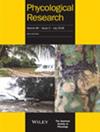基于多相方法在大韩民国分离的Droueella epilithica sp.nov.和Droueeiela lurida(Oculatellaceae,Synechococcales)
IF 1
4区 生物学
Q2 MARINE & FRESHWATER BIOLOGY
引用次数: 0
摘要
从韩国水域、石碑和海岸泥滩的砾石中分离到5株杜洛埃氏菌(ACKU666、667、668、669和670),对其形态和分子特征进行了研究。5个菌株均具有单薄的毛状体和假分支。从这些菌株中,4株ACKU666、667、668和669的细胞长度与德鲁埃氏菌(Drouetiella lurida)等红褐色细胞相似。16S rRNA基因系统发育结果表明,4株菌株与德鲁埃氏菌属同源,DNA相似性为99.1 ~ 100%。菌株ACKU670的颜色呈与束状杜洛埃氏菌相似的亮蓝绿色,其类囊体呈顶状排列,这是眼苔科的特征。根据16S rRNA基因的系统发育分析,菌株ACKU670被证明是D. lurida的姐妹分支。16-23S rRNA内部转录间隔段二级折叠结构(D1-D1 ', Box‐B和V3螺旋)证实了菌株ACKU670的独特性,因此表明与相关物种存在差异。综合以上结果,根据《国际藻类、真菌和植物命名规范》,将菌株ACKU670命名为Drouetiella epilithica sp. 11。本文章由计算机程序翻译,如有差异,请以英文原文为准。
Drouetiella epilithica sp. nov. and Drouetiella lurida (Oculatellaceae, Synechococcales) isolated in the Republic of Korea based on the polyphasic approach
Five strains of Drouetiella (ACKU666, 667, 668, 669 and 670) were isolated from gravels in water, stone monument and coastal mudflat in Korea, and were studied using morphological and molecular traits. All five strains had thin and simple trichomes and exhibited false branching. From these strains, four strains (ACKU666, 667, 668 and 669) exhibited similar cell lengths with reddish–brown colored cells such as Drouetiella lurida. The 16S rRNA gene phylogeny showed the four strains formed a clade with Drouetiella lurida, and their DNA similarity was calculated to be 99.1–100%. The color of strain ACKU670 appeared to be in bright blue–green color like Drouetiella fasciculata, and their thylakoids showed a parietal arrangement, which is a characteristic feature of the family Oculatellaceae. Strain ACKU670 turned out to be a sister clade to the D. lurida according to the phylogenetic analysis of the 16S rRNA gene. The 16–23S rRNA internal transcribed spacer secondary folding structure (D1–D1′, Box‐B and V3 helices) confirmed the uniqueness of strain ACKU670, therefore indicating differences from the related species. Considering all the results, we described our strain ACKU670 as Drouetiella epilithica sp. nov. in accordance with the International Code of Nomenclature for Algae, Fungi and Plants.
求助全文
通过发布文献求助,成功后即可免费获取论文全文。
去求助
来源期刊

Phycological Research
生物-海洋与淡水生物学
CiteScore
3.60
自引率
13.30%
发文量
33
审稿时长
>12 weeks
期刊介绍:
Phycological Research is published by the Japanese Society of Phycology and complements the Japanese Journal of Phycology. The Journal publishes international, basic or applied, peer-reviewed research dealing with all aspects of phycology including ecology, taxonomy and phylogeny, evolution, genetics, molecular biology, biochemistry, cell biology, morphology, physiology, new techniques to facilitate the international exchange of results. All articles are peer-reviewed by at least two researchers expert in the filed of the submitted paper. Phycological Research has been credited by the International Association for Plant Taxonomy for the purpose of registration of new non-vascular plant names (including fossils).
 求助内容:
求助内容: 应助结果提醒方式:
应助结果提醒方式:


